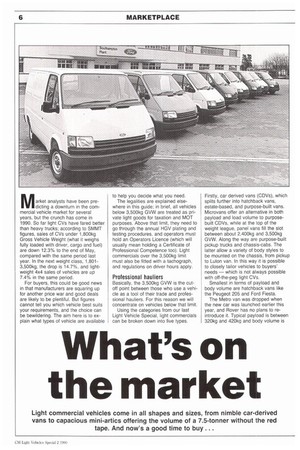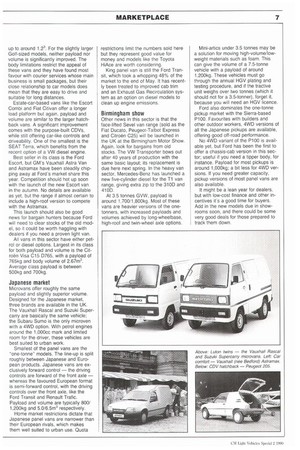What's on the market
Page 90

Page 91

If you've noticed an error in this article please click here to report it so we can fix it.
Light commercial vehicles come in all shapes and sizes, from nimble car-derived vans to capacious mini-artics offering the volume of a 7.5-tonner without the red tape. And now's a good time to buy ...
Market analysts have been predicting a downturn in the commercial vehicle market for several years, but the crunch has come in 1990. So far light CVs have fared better than heavy trucks: according to SMMT figures, sales of CVs under 1,800kg Gross Vehicle Weight (what it weighs fully loaded with driver, cargo and fuel) are down 12.3% to the end of May, compared with the same period last year. In the next weight class, 18013,500kg. the drop is 14.7%, and lightweight 4x4 sales of vehicles are up 7.4% in the same period.
For buyers, this could be good news in that manufacturers are squaring up for another price war and good deals are likely to be plentiful. But figures cannot tell you which vehicle best suits your requirements, and the choice can be bewildering. The aim here is to explain what types of vehicle are available to help you decide what you need.
The legalities are explained elsewhere in this guide; in brief, all vehicles below 3,500kg GVW are treated as private light goods for taxation and MOT purposes. Above that limit, they need to go through the annual HGV plating and testing procedures, and operators must hold an Operators Licence (which will usually mean holding a Certificate of Professional Competence too). Light commercials over the 3,500kg limit must also be fitted with a tachograph, and regulations on driver hours apply.
Professional hauliers Basically, the 3,500kg GVW is the cutoff point between those who use a vehicle as a tool of their trade and professional hauliers. For this reason we will concentrate on vehicles below that limit.
Using the categories from our last Light Vehicle Special, light commercials can be broken down into five types. Firstly, car derived vans (CDVs), which splits further into hatchback vans, estate-based, and purpose-built vans. Microvans offer an alternative in both payload and load volume to purposebuilt CDVs, while at the top of the weight league, panel vans fill the slot between about 2,400kg and 3,500kg GVW. Along the way are purpose-built pickup trucks and chassis-cabs. The latter allow a variety of body styles to be mounted on the chassis, from pickup to Luton van. In this way it is possible to closely tailor vehicles to buyers' needs — which is not always possible with off-the-peg light CVs.
Smallest in terms of payload and body volume are hatchback vans like the Peugeot 205 and Ford Fiesta.
The Metro van was dropped when the new car was launched earlier this year, and Rover has no plans to reintroduce it. Typical payload is between 320kg and 420kg and body volume is
up to around 1.23. For the slightly larger Golf-sized models, neither payload nor volume is significantly improved. The body limitations restrict the appeal of these vans and they have found most favour with courier services whose main business is small packages, but their close relationship to car models does mean that they are easy to drive and suitable for long distances.
Estate-car-based vans like the Escort Combi and Fiat Citivan offer a longer load platform but again, payload and volume are similar to the larger hatchback vans. A significant improvement comes with the purpose-built CDVs, while still offering car-like controls and driveability. One of the smallest is the SEAT Terra, which benefits from the recent option of a VW diesel engine.
Best seller in its class is the Ford Escort, but GM's Vauxhall Astra Van and Astramax have been steadily chipping away at Ford's market share this year. Competition should hot up soon with the launch of the new Escort van in the autumn. No details are available as yet, but the range if almost certain to include a high-roof version to compete with the Astramax.
This launch should also be good news for bargain hunters because Ford will need to clear stocks of the old model, so it could be worth haggling with dealers if you need a proven light van.
All vans in this sector have either petrol or diesel options. Largest in its class for both payload and volume is the Citroen Visa C15 D765, with a payload of 765kg and body volume of 2.67m3. Average class payload is between 500kg and 700kg.
Japanese market Microvans offer roughly the same payload and slightly superior volume. Designed for the Japanese market, Three brands are available in the UK. The Vauxhall Rascal and Suzuki Supercarry are basically the same vehicle; the Subaru Sumo is the only microven with a 4WD option. With petrol engines around the 1,000cc mark and limited room for the driver, these vehicles are best suited to urban work.
Smallest of the panel vans are the "one-tonne" models. The line-up is split roughly between Japanese and European products. Japanese vans are exclusively forward control — the driving controls are forward of the front axle — whereas the favoured European format is semi-forward control, with the driving controls over the front axle, like the Ford Transit and Renault Trafic. Payload and volume are typically 800/ 1,200kg and 5.0/6.5m3 respectively.
Home market restrictions dictate that Japanese panel vans are narrower than their European rivals, which makes them well suited to urban use. Quota restrictions limit the numbers sold here but they represent good value for money and models like the Toyota HiAce are worth considering.
King panel van is still the Ford Transit, which took a whopping 48% of the market to the end of May. It has recently been treated to improved cab trim and an Exhaust Gas Recirculation system as an option on diesel models to clean up engine emissions.
Birmingham show Other news in this sector is that the face-lifted Sevel van range (sold as the Fiat Ducat°, Peugeot-Talbot Express and Citroen C25) will be launched in the UK at the Birmingham Motor Show. Again, look for bargains from old stocks. The VW Transporter bows out after 40 years of production with the same basic layout; its replacement is due here next spring. In the heavy van sector. Mercedes-Benz has launched a new five-cylinder diesel for the Ti van range, giving extra zip to the 310D and 410D.
At 3.5 tonnes GVW, payload is around 1,700/1,800kg, Most of these vans are heavier versions of the onetanners, with increased payloads and volumes achieved by long-wheelbase, high-roof and twin-wheel axle options. Mini-artics under 3.5 tonnes may be a solution for moving high-volume/lowweight materials such as foam. This can give the volume of a 7.5-tonne vehicle with a payload of around 1,200kg. These vehicles must go through the annual HGV plating and testing procedure, and if the tractive unit weighs over two tonnes (which it should not for a 3.5-tanner), forget it, because you will need an HGV licence.
Ford also dominates the one-tonne pickup market with the Sierra-based P100. Favourites with builders and other outdoor workers, 4WD versions of all the Japanese pickups are available, offering good off-road performance.
No 4WD variant of the P100 is available yet, but Ford has been the first to offer a chassis-cab version in this sector; useful if you need a tipper body, for instance. Payload for most pickups is around 1,000kg; a bit less for 4WD versions. If you need greater capacity, pickup versions of most panel vans are also available.
It might be a lean year for dealers, but with low-cost finance and other incentives its a good time for buyers. Add in the new models due in showrooms soon, and there could be some very good deals for those prepared to track them down.
















































































































